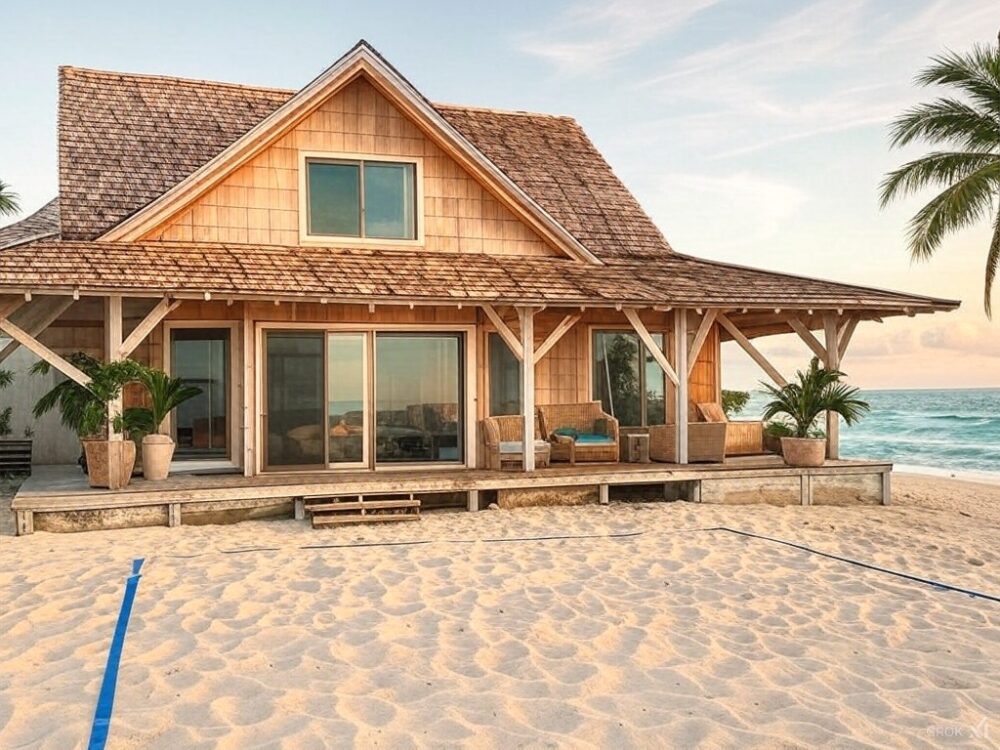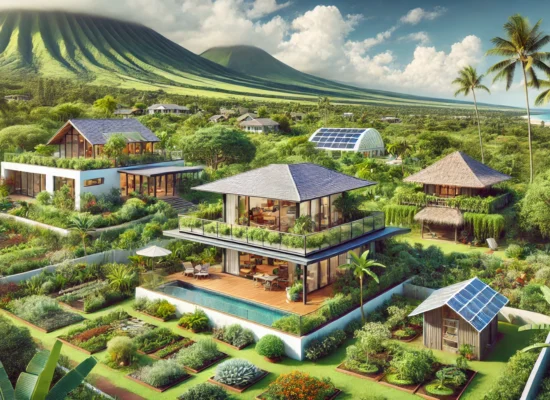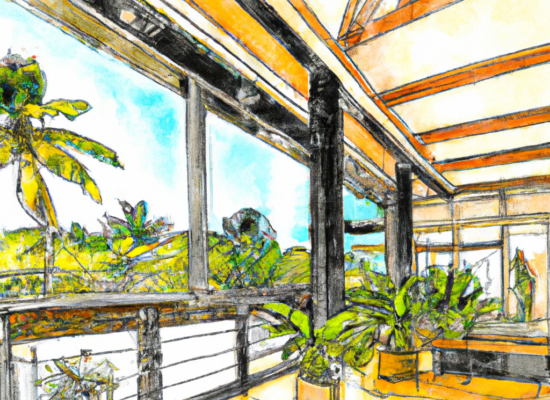Living on the Edge: Designing for Hawaii’s Changing Shoreline
Owning a home on Hawaii’s coast is a dream—oceanfront views, warm tradewinds, and that effortless island lifestyle. But for those designing or maintaining a coastal home, rising sea levels are an ever-growing concern.
Let’s say you have an Aunty in Makaha or Kaneohe, for example. She has lived in her cottage for 30 years, just steps from the shoreline. “I used to walk to the water,” she recalls. “Now, it’s coming to me.” Last winter, a king tide—an extreme high tide fueled by weather patterns—flooded her yard, soaked her lanai, and left her questioning how long her home could withstand the encroaching sea. “I’m not ready to leave,” she says, “but I need a plan.”
She isn’t alone. Homeowners across the islands, from Kapoho to Hanalei, are grappling with the same issue. According to the Hawaii Sea Level Rise Vulnerability and Adaptation Report, sea levels in Hawaii are projected to rise by 3.2 feet by 2100. This means more than just flooding—it threatens beaches, accelerates erosion, and impacts property values. But here’s the good news: strategic coastal home design can protect properties and allow homeowners to coexist with a changing environment.
If you’re designing a new home or retrofitting an existing one, here’s what you need to know to keep your slice of paradise safe for generations to come.
Hawaii’s Unique Vulnerability to Sea Level Rise
Hawaii’s breathtaking coastlines, from the black sands of Punalu’u to the golden beaches of Waikiki, are not just picturesque—they are also on the front lines of climate change. Rising sea levels pose a threefold threat: flooding, erosion, and saltwater intrusion.
The impacts are already evident:
- Erosion is accelerating – Over 70% of Hawaii’s beaches are experiencing erosion, with some areas losing one to two feet per year. Coastal landmarks like Punalu’u Black Sand Beach, reshaped by Kilauea’s lava flow in 1990, now face the relentless advance of rising seas.
- King tides and storm surges are worsening – Once rare, extreme high tides and storms now routinely flood low-lying areas, turning roads into rivers and damaging homes.
- Saltwater intrusion threatens freshwater resources – As seawater seeps into underground aquifers, it compromises drinking water supplies and agricultural sustainability.
Hawaii’s remote Pacific location makes it particularly susceptible. Natural subsidence (land sinking) compounds the effects of sea level rise, while storms, trade winds, and seasonal swells accelerate coastal damage. The National Oceanic and Atmospheric Administration (NOAA) estimates global sea levels could rise between 1 to 4 feet by 2100, but in Hawaii’s low-lying areas, the impact could be even more severe.
For many residents, the changes are personal. Kimo, a lifelong Haleiwa resident, sees it firsthand. “My ohana’s been here forever,” he says, watching the dunes in front of his home shrink after each storm. “Now I’m stacking sandbags every year.”
Despite these challenges, Hawaii has always been resilient—surviving tsunamis, hurricanes, and volcanic eruptions. With proactive planning, new building codes, and smarter home designs, Hawaii homeowners can safeguard their properties and continue to thrive along the coast.
Strategy 1: Elevate Your Home to Stay Above the Waterline
One of the most effective ways to safeguard a coastal home is elevation. Raising a home above flood-prone levels can prevent costly water damage and ensure long-term stability. In Hawaii, several practical foundation options are used to elevate homes safely:
Elevated Foundations for Sandy Coastal Areas
For homes near sandy shores, CMU (concrete masonry unit) columns, Sonotube-formed concrete columns, or wood columns placed on concrete or CMU pedestals are the most common elevation solutions. These provide strong, stable support while resisting saltwater exposure, termites, and erosion.
Most elevated home foundations also incorporate concrete grade beams that connect the column footings, preventing them from shifting over time. In some cases, micropiles—small-diameter, high-strength piles—are also used for additional support in areas with unstable soil conditions.
This structural system allows water to flow underneath the home during storms or high tides, minimizing flood damage. It also provides necessary bracing against high winds and hurricanes, ensuring long-term durability in Hawaii’s coastal environments.
Pier and Beam Foundations for Rocky Terrain
For homes built on uneven or rocky ground, such as those on Oahu’s windward cliffs or Kauai’s rugged coastline, pier and beam foundations are a sturdy and adaptable solution. This system involves concrete piers anchored into bedrock, with beams that support the elevated structure above.
While pressure-treated wood beams are the most commonly used material for elevated homes in Hawaii, steel beams are occasionally used, particularly for long spans requiring additional strength. Reinforced concrete beams are seldom utilized due to their increased difficulty in construction and long curing times, which can slow down the building process. Wood is preferred for its availability, ease of construction, and cost-effectiveness, while steel is chosen selectively for structural integrity where needed. This type of foundation system, regardless of material, allows for future elevation adjustments if sea levels continue to rise, making it significantly easier to lift a house compared to one built on a slab or foundation walls.
Strategy 2: Armor Up with Flood-Resistant Materials
Water’s ruthless—rots wood, rusts steel, dissolves drywall. Hawaii’s salt and humidity double the punishment. Flood-resistant materials are your shield—here’s the lineup.
Best Materials for Flood-Resistant Homes:
✔ Fiber-cement siding – Highly durable, resists rot, and withstands hurricane-force winds. Ideal for exterior walls in high-moisture environments.
✔ Marine-grade plywood – Designed for moisture exposure, ideal for structural framing and subflooring in flood-prone areas.
✔ Stainless steel fasteners – Prevents rust and corrosion in salty air, ensuring longevity for coastal home construction.
✔ Tile or stone flooring – Water-resistant, easy to clean after a flood, and less likely to warp compared to wood or laminate.
✔ Breakaway walls – Designed for uninhabited areas beneath raised homes, these walls detach under extreme flood conditions, reducing structural stress and allowing water to flow through.
✔ Closed-cell spray foam insulation – More resistant to water damage than traditional insulation, reducing mold growth and retaining structural integrity after flooding.
✔ Composite decking – Resists moisture, warping, and decay, making it a durable alternative to traditional wood for outdoor spaces in flood-prone regions.
By incorporating these flood-resistant materials, homeowners in Hawaii can enhance the durability of their coastal properties while mitigating the risks associated with sea-level rise and extreme weather events.
Where to Get It
Locals swear by HPM Building Supply—grab fiber-cement or marine plywood there. Test it yourself: soak samples in saltwater a week. Expect 20-30% more cost than standard gear, but it lasts decades, not seasons.
The Seawall Debate: Solution or Problem?
Seawalls may seem like an effective solution for protecting coastal properties, but they come with significant drawbacks. These structures disrupt natural coastal processes by reflecting wave energy, which accelerates beach erosion. Because of these negative effects, Hawaii has largely banned the construction of new seawalls.
What the Law Says
- Act 16, Session Laws of Hawaii 2020 restricts shoreline hardening structures unless they serve a compelling public interest.
- Property owners cannot construct new seawalls but may maintain or repair existing ones under strict regulations.
- Unauthorized construction can result in significant fines and legal action.
A recent case on Oahu’s North Shore illustrates the consequences—after a homeowner attempted unauthorized erosion control, his home collapsed into the ocean, causing environmental damage and leading to legal action by the state.
Better Alternatives to Seawalls
🌱 Living shorelines – Utilizing native vegetation, dunes, and coral reefs to create natural barriers that absorb wave energy and reduce erosion.
🏖 Beach nourishment – Periodically adding sand to eroding beaches, a method used successfully at Waimea Bay.
🏡 Managed retreat – Strategically relocating structures inland to accommodate natural shoreline migration and sea-level rise.
Building Smarter: Why Professional Expertise Matters
Coastal construction in Hawaii requires specialized knowledge—flood zones, building codes, and climate risks must all be considered. While DIY projects are tempting, hiring a structural engineer and architect ensures compliance with local regulations and maximizes resilience.
If you’re planning a coastal home in Hawaii, Owner Built Design offers expert guidance on designing structures that withstand the elements while preserving the beauty of island living.
Final Thoughts: Building Resilient Coastal Homes in Hawaii
Designing homes in Hawaii’s coastal areas requires a proactive approach to mitigate the impacts of rising sea levels and extreme weather conditions. Implementing elevated foundation systems, flood-resistant materials, and adaptable home designs can ensure that structures remain durable and functional for generations to come.
By elevating homes above flood-prone levels, homeowners can protect their properties from storm surges and tidal flooding. Choosing flood-resistant materials, such as fiber-cement siding and marine-grade plywood, reduces maintenance costs and extends the lifespan of coastal homes. Additionally, designing with sacrificial spaces and breakaway walls allows water to flow through non-essential areas, preventing major structural damage.
With careful planning and the right construction strategies, coastal homeowners in Hawaii can continue to enjoy the beauty and benefits of oceanfront living while staying prepared for future environmental challenges. Investing in these adaptive solutions today will help ensure a resilient, sustainable, and secure coastal lifestyle for years to come.
Learn More
Dig deeper with these:
-
- Book: The Water Will Come by Jeff Goodell – Sea level rise, real talk, with homeowner tips.
- Article: “Building Resilience in Hawaii” – Local scoop on fighting the tides.
- Tool: NOAA Sea Level Rise Viewer – Map your risk, island-style.
- Guide: Hawaii Homeowner’s Handbook to Prepare for Natural Hazards – Free UH Sea Grant gold.
References
-
- Hawaii Sea Level Rise Vulnerability and Adaptation Report – dlnr.hawaii.gov
-
- NOAA Coastal Services Center – coast.noaa.gov/slr
- Hawaii Business Magazine – hawaiibusiness.com



